Water and Energy Sustainability Report
VerifiedAdded on 2020/03/16
|10
|2310
|54
Report
AI Summary
This report examines the current scenarios of water and energy sustainability in Australia and India, highlighting the challenges faced by both countries. It discusses governmental and non-governmental initiatives aimed at promoting sustainable practices, comparing the effectiveness of policies and innovations in each nation. The report concludes with recommendations for enhancing sustainability efforts in both countries.
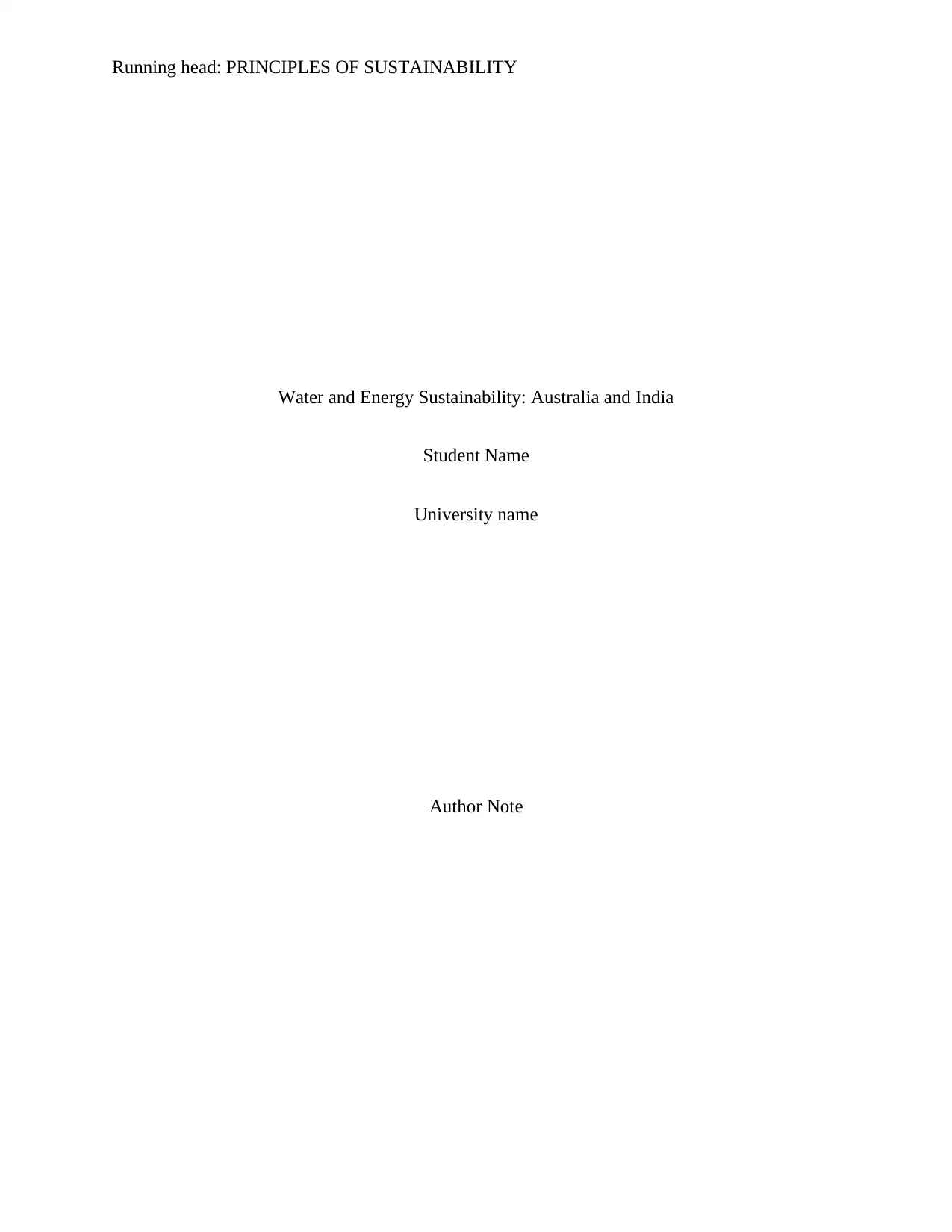
Running head: PRINCIPLES OF SUSTAINABILITY
Water and Energy Sustainability: Australia and India
Student Name
University name
Author Note
Water and Energy Sustainability: Australia and India
Student Name
University name
Author Note
Paraphrase This Document
Need a fresh take? Get an instant paraphrase of this document with our AI Paraphraser
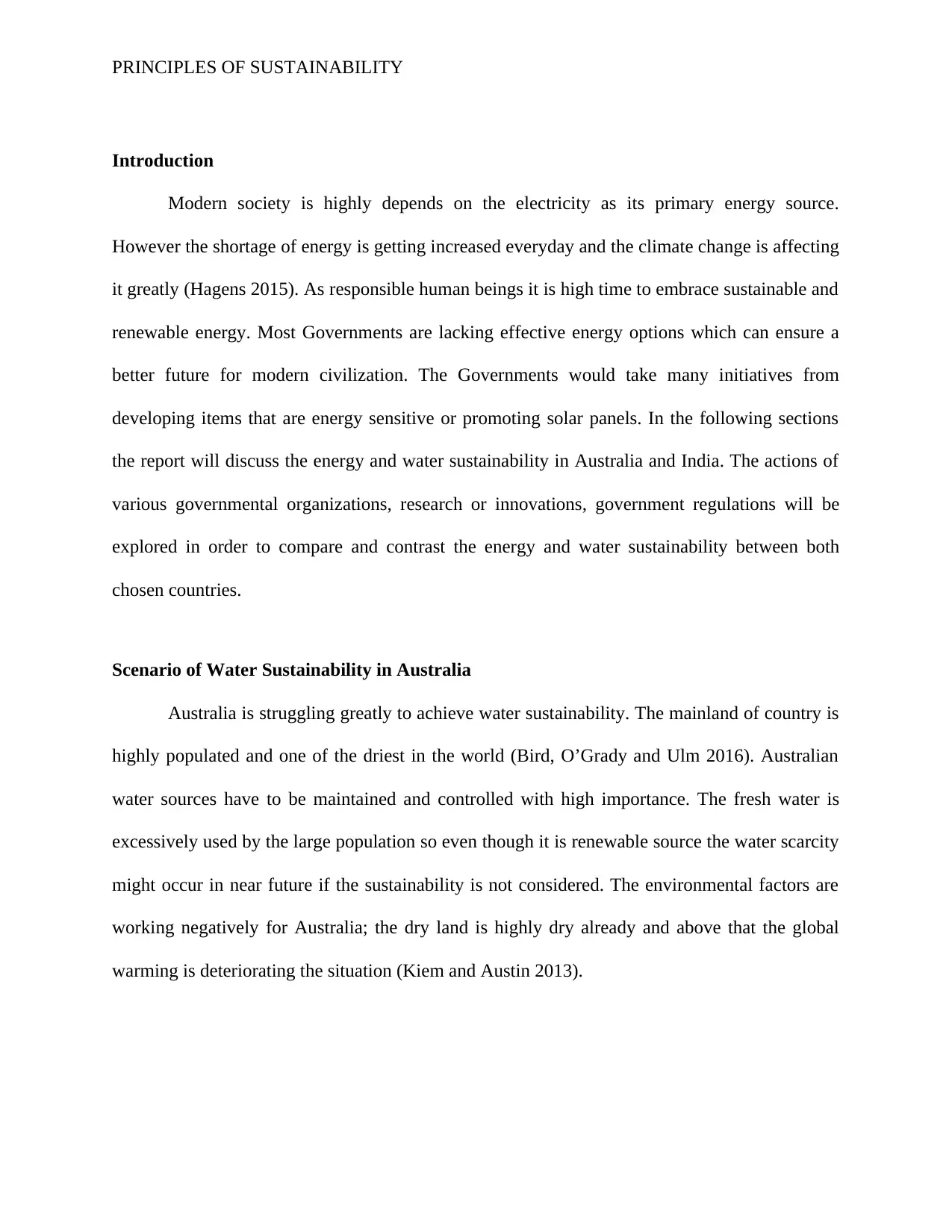
PRINCIPLES OF SUSTAINABILITY
Introduction
Modern society is highly depends on the electricity as its primary energy source.
However the shortage of energy is getting increased everyday and the climate change is affecting
it greatly (Hagens 2015). As responsible human beings it is high time to embrace sustainable and
renewable energy. Most Governments are lacking effective energy options which can ensure a
better future for modern civilization. The Governments would take many initiatives from
developing items that are energy sensitive or promoting solar panels. In the following sections
the report will discuss the energy and water sustainability in Australia and India. The actions of
various governmental organizations, research or innovations, government regulations will be
explored in order to compare and contrast the energy and water sustainability between both
chosen countries.
Scenario of Water Sustainability in Australia
Australia is struggling greatly to achieve water sustainability. The mainland of country is
highly populated and one of the driest in the world (Bird, O’Grady and Ulm 2016). Australian
water sources have to be maintained and controlled with high importance. The fresh water is
excessively used by the large population so even though it is renewable source the water scarcity
might occur in near future if the sustainability is not considered. The environmental factors are
working negatively for Australia; the dry land is highly dry already and above that the global
warming is deteriorating the situation (Kiem and Austin 2013).
Introduction
Modern society is highly depends on the electricity as its primary energy source.
However the shortage of energy is getting increased everyday and the climate change is affecting
it greatly (Hagens 2015). As responsible human beings it is high time to embrace sustainable and
renewable energy. Most Governments are lacking effective energy options which can ensure a
better future for modern civilization. The Governments would take many initiatives from
developing items that are energy sensitive or promoting solar panels. In the following sections
the report will discuss the energy and water sustainability in Australia and India. The actions of
various governmental organizations, research or innovations, government regulations will be
explored in order to compare and contrast the energy and water sustainability between both
chosen countries.
Scenario of Water Sustainability in Australia
Australia is struggling greatly to achieve water sustainability. The mainland of country is
highly populated and one of the driest in the world (Bird, O’Grady and Ulm 2016). Australian
water sources have to be maintained and controlled with high importance. The fresh water is
excessively used by the large population so even though it is renewable source the water scarcity
might occur in near future if the sustainability is not considered. The environmental factors are
working negatively for Australia; the dry land is highly dry already and above that the global
warming is deteriorating the situation (Kiem and Austin 2013).
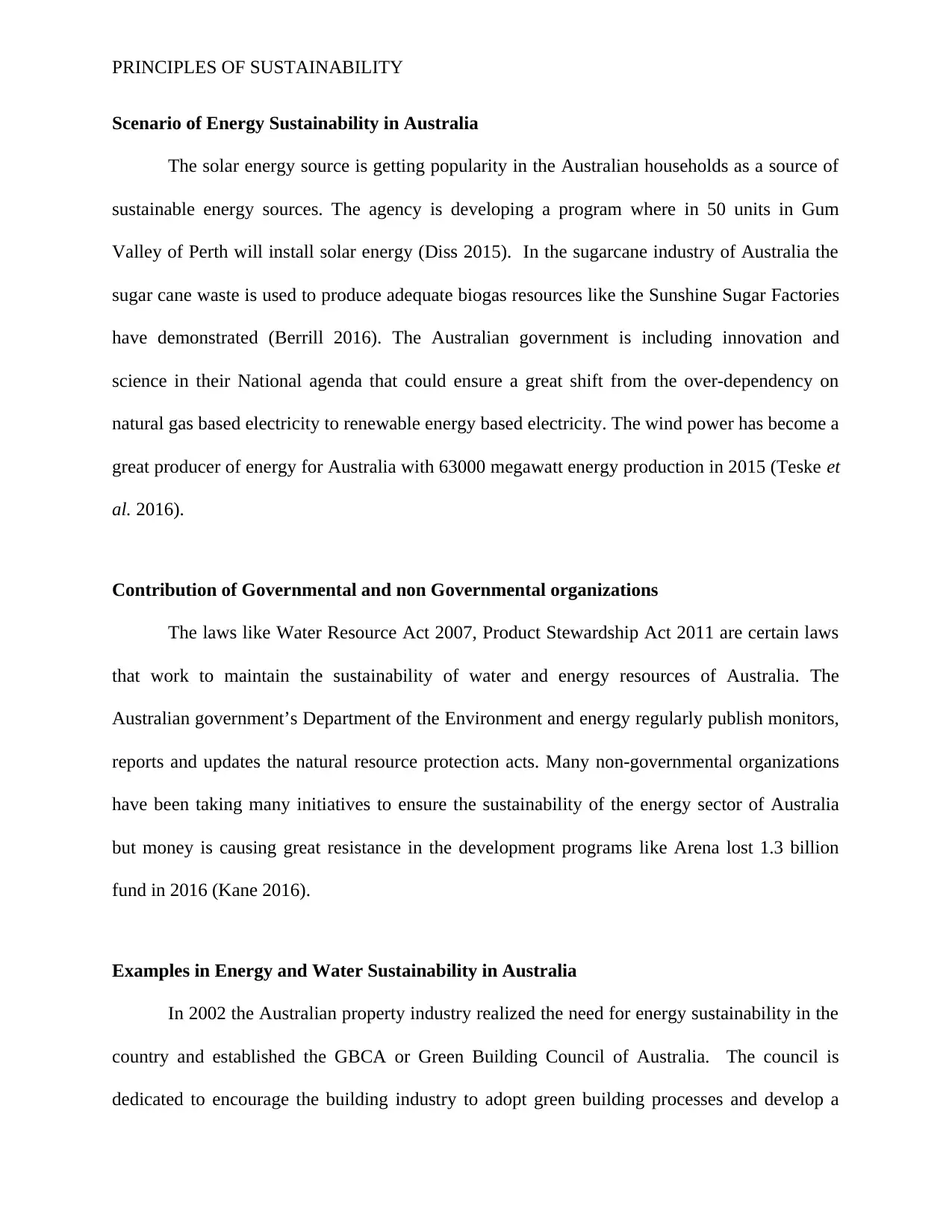
PRINCIPLES OF SUSTAINABILITY
Scenario of Energy Sustainability in Australia
The solar energy source is getting popularity in the Australian households as a source of
sustainable energy sources. The agency is developing a program where in 50 units in Gum
Valley of Perth will install solar energy (Diss 2015). In the sugarcane industry of Australia the
sugar cane waste is used to produce adequate biogas resources like the Sunshine Sugar Factories
have demonstrated (Berrill 2016). The Australian government is including innovation and
science in their National agenda that could ensure a great shift from the over-dependency on
natural gas based electricity to renewable energy based electricity. The wind power has become a
great producer of energy for Australia with 63000 megawatt energy production in 2015 (Teske et
al. 2016).
Contribution of Governmental and non Governmental organizations
The laws like Water Resource Act 2007, Product Stewardship Act 2011 are certain laws
that work to maintain the sustainability of water and energy resources of Australia. The
Australian government’s Department of the Environment and energy regularly publish monitors,
reports and updates the natural resource protection acts. Many non-governmental organizations
have been taking many initiatives to ensure the sustainability of the energy sector of Australia
but money is causing great resistance in the development programs like Arena lost 1.3 billion
fund in 2016 (Kane 2016).
Examples in Energy and Water Sustainability in Australia
In 2002 the Australian property industry realized the need for energy sustainability in the
country and established the GBCA or Green Building Council of Australia. The council is
dedicated to encourage the building industry to adopt green building processes and develop a
Scenario of Energy Sustainability in Australia
The solar energy source is getting popularity in the Australian households as a source of
sustainable energy sources. The agency is developing a program where in 50 units in Gum
Valley of Perth will install solar energy (Diss 2015). In the sugarcane industry of Australia the
sugar cane waste is used to produce adequate biogas resources like the Sunshine Sugar Factories
have demonstrated (Berrill 2016). The Australian government is including innovation and
science in their National agenda that could ensure a great shift from the over-dependency on
natural gas based electricity to renewable energy based electricity. The wind power has become a
great producer of energy for Australia with 63000 megawatt energy production in 2015 (Teske et
al. 2016).
Contribution of Governmental and non Governmental organizations
The laws like Water Resource Act 2007, Product Stewardship Act 2011 are certain laws
that work to maintain the sustainability of water and energy resources of Australia. The
Australian government’s Department of the Environment and energy regularly publish monitors,
reports and updates the natural resource protection acts. Many non-governmental organizations
have been taking many initiatives to ensure the sustainability of the energy sector of Australia
but money is causing great resistance in the development programs like Arena lost 1.3 billion
fund in 2016 (Kane 2016).
Examples in Energy and Water Sustainability in Australia
In 2002 the Australian property industry realized the need for energy sustainability in the
country and established the GBCA or Green Building Council of Australia. The council is
dedicated to encourage the building industry to adopt green building processes and develop a
⊘ This is a preview!⊘
Do you want full access?
Subscribe today to unlock all pages.

Trusted by 1+ million students worldwide
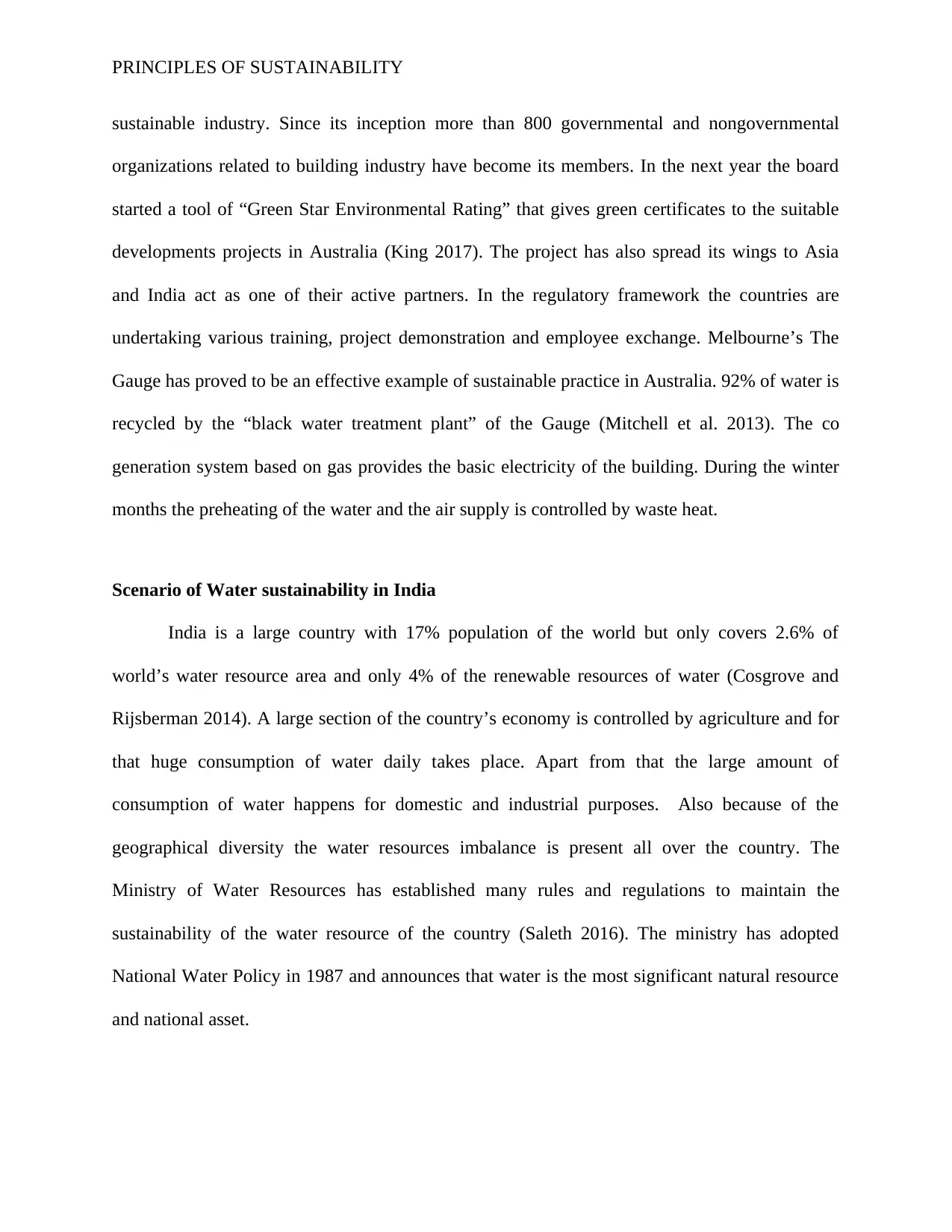
PRINCIPLES OF SUSTAINABILITY
sustainable industry. Since its inception more than 800 governmental and nongovernmental
organizations related to building industry have become its members. In the next year the board
started a tool of “Green Star Environmental Rating” that gives green certificates to the suitable
developments projects in Australia (King 2017). The project has also spread its wings to Asia
and India act as one of their active partners. In the regulatory framework the countries are
undertaking various training, project demonstration and employee exchange. Melbourne’s The
Gauge has proved to be an effective example of sustainable practice in Australia. 92% of water is
recycled by the “black water treatment plant” of the Gauge (Mitchell et al. 2013). The co
generation system based on gas provides the basic electricity of the building. During the winter
months the preheating of the water and the air supply is controlled by waste heat.
Scenario of Water sustainability in India
India is a large country with 17% population of the world but only covers 2.6% of
world’s water resource area and only 4% of the renewable resources of water (Cosgrove and
Rijsberman 2014). A large section of the country’s economy is controlled by agriculture and for
that huge consumption of water daily takes place. Apart from that the large amount of
consumption of water happens for domestic and industrial purposes. Also because of the
geographical diversity the water resources imbalance is present all over the country. The
Ministry of Water Resources has established many rules and regulations to maintain the
sustainability of the water resource of the country (Saleth 2016). The ministry has adopted
National Water Policy in 1987 and announces that water is the most significant natural resource
and national asset.
sustainable industry. Since its inception more than 800 governmental and nongovernmental
organizations related to building industry have become its members. In the next year the board
started a tool of “Green Star Environmental Rating” that gives green certificates to the suitable
developments projects in Australia (King 2017). The project has also spread its wings to Asia
and India act as one of their active partners. In the regulatory framework the countries are
undertaking various training, project demonstration and employee exchange. Melbourne’s The
Gauge has proved to be an effective example of sustainable practice in Australia. 92% of water is
recycled by the “black water treatment plant” of the Gauge (Mitchell et al. 2013). The co
generation system based on gas provides the basic electricity of the building. During the winter
months the preheating of the water and the air supply is controlled by waste heat.
Scenario of Water sustainability in India
India is a large country with 17% population of the world but only covers 2.6% of
world’s water resource area and only 4% of the renewable resources of water (Cosgrove and
Rijsberman 2014). A large section of the country’s economy is controlled by agriculture and for
that huge consumption of water daily takes place. Apart from that the large amount of
consumption of water happens for domestic and industrial purposes. Also because of the
geographical diversity the water resources imbalance is present all over the country. The
Ministry of Water Resources has established many rules and regulations to maintain the
sustainability of the water resource of the country (Saleth 2016). The ministry has adopted
National Water Policy in 1987 and announces that water is the most significant natural resource
and national asset.
Paraphrase This Document
Need a fresh take? Get an instant paraphrase of this document with our AI Paraphraser
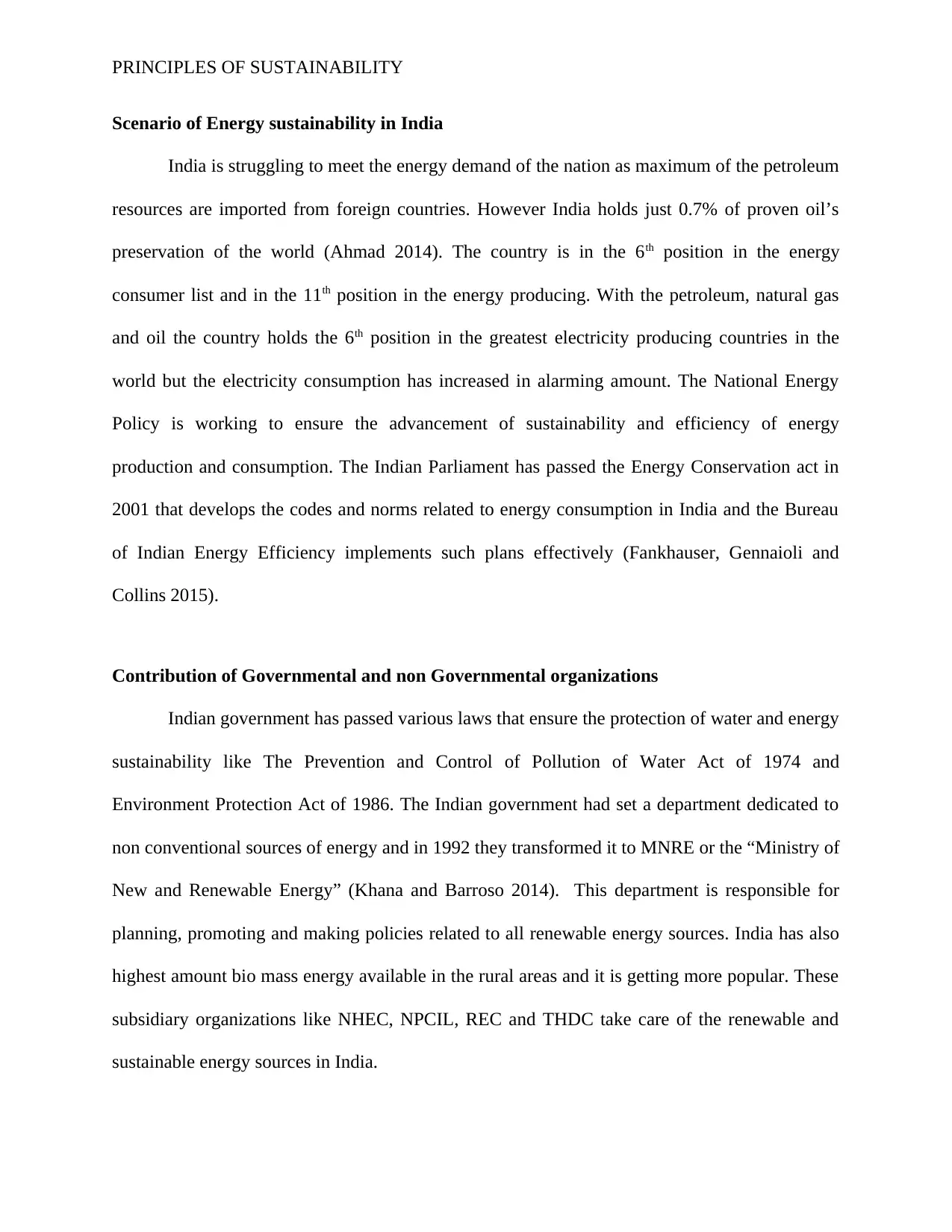
PRINCIPLES OF SUSTAINABILITY
Scenario of Energy sustainability in India
India is struggling to meet the energy demand of the nation as maximum of the petroleum
resources are imported from foreign countries. However India holds just 0.7% of proven oil’s
preservation of the world (Ahmad 2014). The country is in the 6th position in the energy
consumer list and in the 11th position in the energy producing. With the petroleum, natural gas
and oil the country holds the 6th position in the greatest electricity producing countries in the
world but the electricity consumption has increased in alarming amount. The National Energy
Policy is working to ensure the advancement of sustainability and efficiency of energy
production and consumption. The Indian Parliament has passed the Energy Conservation act in
2001 that develops the codes and norms related to energy consumption in India and the Bureau
of Indian Energy Efficiency implements such plans effectively (Fankhauser, Gennaioli and
Collins 2015).
Contribution of Governmental and non Governmental organizations
Indian government has passed various laws that ensure the protection of water and energy
sustainability like The Prevention and Control of Pollution of Water Act of 1974 and
Environment Protection Act of 1986. The Indian government had set a department dedicated to
non conventional sources of energy and in 1992 they transformed it to MNRE or the “Ministry of
New and Renewable Energy” (Khana and Barroso 2014). This department is responsible for
planning, promoting and making policies related to all renewable energy sources. India has also
highest amount bio mass energy available in the rural areas and it is getting more popular. These
subsidiary organizations like NHEC, NPCIL, REC and THDC take care of the renewable and
sustainable energy sources in India.
Scenario of Energy sustainability in India
India is struggling to meet the energy demand of the nation as maximum of the petroleum
resources are imported from foreign countries. However India holds just 0.7% of proven oil’s
preservation of the world (Ahmad 2014). The country is in the 6th position in the energy
consumer list and in the 11th position in the energy producing. With the petroleum, natural gas
and oil the country holds the 6th position in the greatest electricity producing countries in the
world but the electricity consumption has increased in alarming amount. The National Energy
Policy is working to ensure the advancement of sustainability and efficiency of energy
production and consumption. The Indian Parliament has passed the Energy Conservation act in
2001 that develops the codes and norms related to energy consumption in India and the Bureau
of Indian Energy Efficiency implements such plans effectively (Fankhauser, Gennaioli and
Collins 2015).
Contribution of Governmental and non Governmental organizations
Indian government has passed various laws that ensure the protection of water and energy
sustainability like The Prevention and Control of Pollution of Water Act of 1974 and
Environment Protection Act of 1986. The Indian government had set a department dedicated to
non conventional sources of energy and in 1992 they transformed it to MNRE or the “Ministry of
New and Renewable Energy” (Khana and Barroso 2014). This department is responsible for
planning, promoting and making policies related to all renewable energy sources. India has also
highest amount bio mass energy available in the rural areas and it is getting more popular. These
subsidiary organizations like NHEC, NPCIL, REC and THDC take care of the renewable and
sustainable energy sources in India.
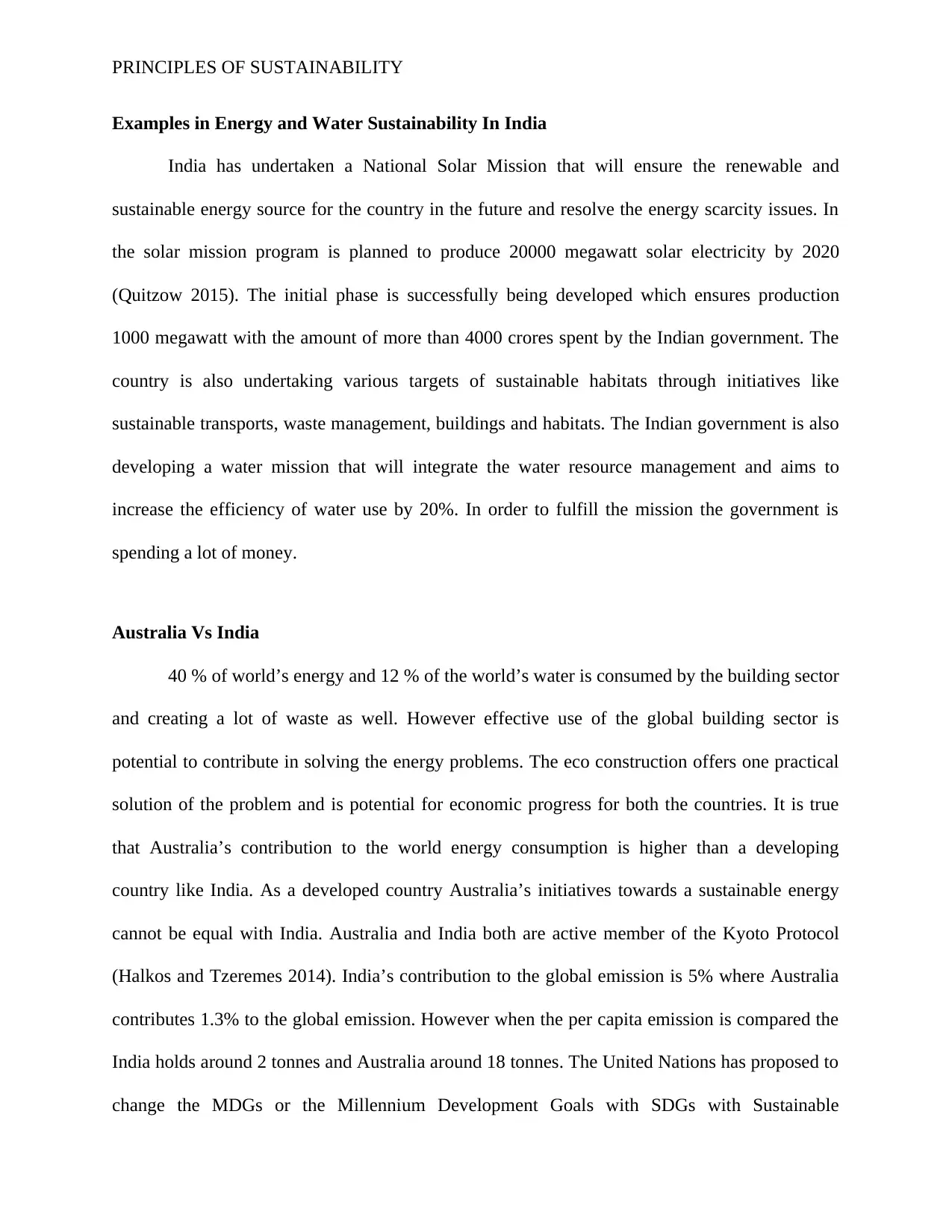
PRINCIPLES OF SUSTAINABILITY
Examples in Energy and Water Sustainability In India
India has undertaken a National Solar Mission that will ensure the renewable and
sustainable energy source for the country in the future and resolve the energy scarcity issues. In
the solar mission program is planned to produce 20000 megawatt solar electricity by 2020
(Quitzow 2015). The initial phase is successfully being developed which ensures production
1000 megawatt with the amount of more than 4000 crores spent by the Indian government. The
country is also undertaking various targets of sustainable habitats through initiatives like
sustainable transports, waste management, buildings and habitats. The Indian government is also
developing a water mission that will integrate the water resource management and aims to
increase the efficiency of water use by 20%. In order to fulfill the mission the government is
spending a lot of money.
Australia Vs India
40 % of world’s energy and 12 % of the world’s water is consumed by the building sector
and creating a lot of waste as well. However effective use of the global building sector is
potential to contribute in solving the energy problems. The eco construction offers one practical
solution of the problem and is potential for economic progress for both the countries. It is true
that Australia’s contribution to the world energy consumption is higher than a developing
country like India. As a developed country Australia’s initiatives towards a sustainable energy
cannot be equal with India. Australia and India both are active member of the Kyoto Protocol
(Halkos and Tzeremes 2014). India’s contribution to the global emission is 5% where Australia
contributes 1.3% to the global emission. However when the per capita emission is compared the
India holds around 2 tonnes and Australia around 18 tonnes. The United Nations has proposed to
change the MDGs or the Millennium Development Goals with SDGs with Sustainable
Examples in Energy and Water Sustainability In India
India has undertaken a National Solar Mission that will ensure the renewable and
sustainable energy source for the country in the future and resolve the energy scarcity issues. In
the solar mission program is planned to produce 20000 megawatt solar electricity by 2020
(Quitzow 2015). The initial phase is successfully being developed which ensures production
1000 megawatt with the amount of more than 4000 crores spent by the Indian government. The
country is also undertaking various targets of sustainable habitats through initiatives like
sustainable transports, waste management, buildings and habitats. The Indian government is also
developing a water mission that will integrate the water resource management and aims to
increase the efficiency of water use by 20%. In order to fulfill the mission the government is
spending a lot of money.
Australia Vs India
40 % of world’s energy and 12 % of the world’s water is consumed by the building sector
and creating a lot of waste as well. However effective use of the global building sector is
potential to contribute in solving the energy problems. The eco construction offers one practical
solution of the problem and is potential for economic progress for both the countries. It is true
that Australia’s contribution to the world energy consumption is higher than a developing
country like India. As a developed country Australia’s initiatives towards a sustainable energy
cannot be equal with India. Australia and India both are active member of the Kyoto Protocol
(Halkos and Tzeremes 2014). India’s contribution to the global emission is 5% where Australia
contributes 1.3% to the global emission. However when the per capita emission is compared the
India holds around 2 tonnes and Australia around 18 tonnes. The United Nations has proposed to
change the MDGs or the Millennium Development Goals with SDGs with Sustainable
⊘ This is a preview!⊘
Do you want full access?
Subscribe today to unlock all pages.

Trusted by 1+ million students worldwide
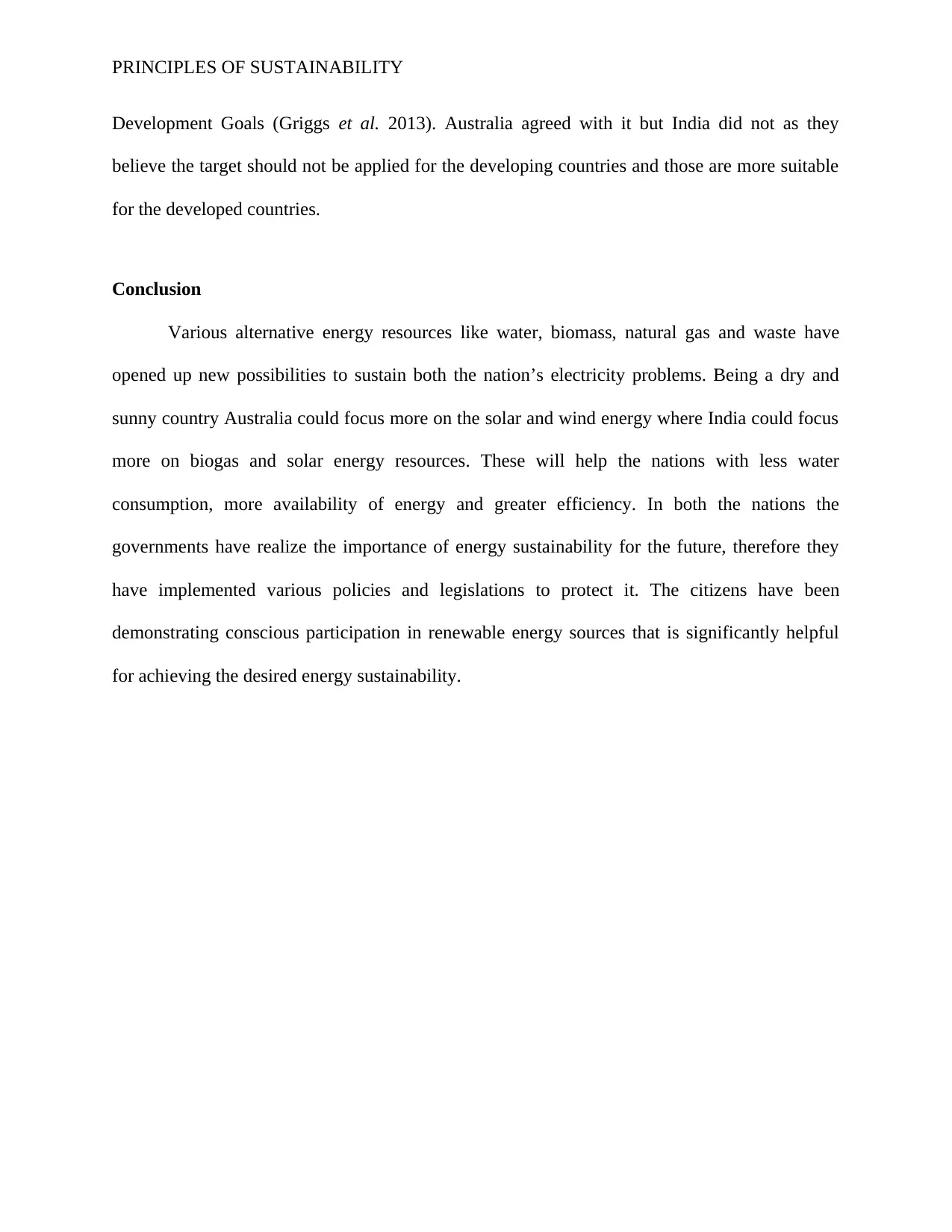
PRINCIPLES OF SUSTAINABILITY
Development Goals (Griggs et al. 2013). Australia agreed with it but India did not as they
believe the target should not be applied for the developing countries and those are more suitable
for the developed countries.
Conclusion
Various alternative energy resources like water, biomass, natural gas and waste have
opened up new possibilities to sustain both the nation’s electricity problems. Being a dry and
sunny country Australia could focus more on the solar and wind energy where India could focus
more on biogas and solar energy resources. These will help the nations with less water
consumption, more availability of energy and greater efficiency. In both the nations the
governments have realize the importance of energy sustainability for the future, therefore they
have implemented various policies and legislations to protect it. The citizens have been
demonstrating conscious participation in renewable energy sources that is significantly helpful
for achieving the desired energy sustainability.
Development Goals (Griggs et al. 2013). Australia agreed with it but India did not as they
believe the target should not be applied for the developing countries and those are more suitable
for the developed countries.
Conclusion
Various alternative energy resources like water, biomass, natural gas and waste have
opened up new possibilities to sustain both the nation’s electricity problems. Being a dry and
sunny country Australia could focus more on the solar and wind energy where India could focus
more on biogas and solar energy resources. These will help the nations with less water
consumption, more availability of energy and greater efficiency. In both the nations the
governments have realize the importance of energy sustainability for the future, therefore they
have implemented various policies and legislations to protect it. The citizens have been
demonstrating conscious participation in renewable energy sources that is significantly helpful
for achieving the desired energy sustainability.
Paraphrase This Document
Need a fresh take? Get an instant paraphrase of this document with our AI Paraphraser

PRINCIPLES OF SUSTAINABILITY
Reference
Ahmad, B.M., 2014. America and Iran-Pakistan-India (IPI) Gas Pipeline. African Journal of
Political Science and International Relations, 8(8), pp.260-265.
Berrill, T., 2016. The Renewable Energy Revolution Real Climate Action in the Sunshine State.
Bird, M.I., O’Grady, D. and Ulm, S., 2016. Humans, water, and the colonization of
Australia. Proceedings of the National Academy of Sciences, 113(41), pp.11477-11482.
Cosgrove, W.J. and Rijsberman, F.R., 2014. World water vision: making water everybody's
business. Routledge.
Diss, K. (2015). Green energy in White Gum Valley 'an Australian first'. [online] ABC News.
Available at: http://www.abc.net.au/news/2015-06-17/green-energy-for-new-white-gum-valley-
residents/6553896 [Accessed 9 Oct. 2017].
Fankhauser, S., Gennaioli, C. and Collins, M., 2015. The political economy of passing climate
change legislation: Evidence from a survey. Global Environmental Change, 35, pp.52-61.
Griggs, D., Stafford-Smith, M., Gaffney, O., Rockström, J., Öhman, M.C., Shyamsundar, P.,
Steffen, W., Glaser, G., Kanie, N. and Noble, I., 2013. Policy: Sustainable development goals for
people and planet. Nature, 495(7441), pp.305-307.
Hagens, N.J., 2015. Energy, Credit, and the End of Growth. In State of the World 2015 (pp. 21-
35). Island Press/Center for Resource Economics.
Reference
Ahmad, B.M., 2014. America and Iran-Pakistan-India (IPI) Gas Pipeline. African Journal of
Political Science and International Relations, 8(8), pp.260-265.
Berrill, T., 2016. The Renewable Energy Revolution Real Climate Action in the Sunshine State.
Bird, M.I., O’Grady, D. and Ulm, S., 2016. Humans, water, and the colonization of
Australia. Proceedings of the National Academy of Sciences, 113(41), pp.11477-11482.
Cosgrove, W.J. and Rijsberman, F.R., 2014. World water vision: making water everybody's
business. Routledge.
Diss, K. (2015). Green energy in White Gum Valley 'an Australian first'. [online] ABC News.
Available at: http://www.abc.net.au/news/2015-06-17/green-energy-for-new-white-gum-valley-
residents/6553896 [Accessed 9 Oct. 2017].
Fankhauser, S., Gennaioli, C. and Collins, M., 2015. The political economy of passing climate
change legislation: Evidence from a survey. Global Environmental Change, 35, pp.52-61.
Griggs, D., Stafford-Smith, M., Gaffney, O., Rockström, J., Öhman, M.C., Shyamsundar, P.,
Steffen, W., Glaser, G., Kanie, N. and Noble, I., 2013. Policy: Sustainable development goals for
people and planet. Nature, 495(7441), pp.305-307.
Hagens, N.J., 2015. Energy, Credit, and the End of Growth. In State of the World 2015 (pp. 21-
35). Island Press/Center for Resource Economics.
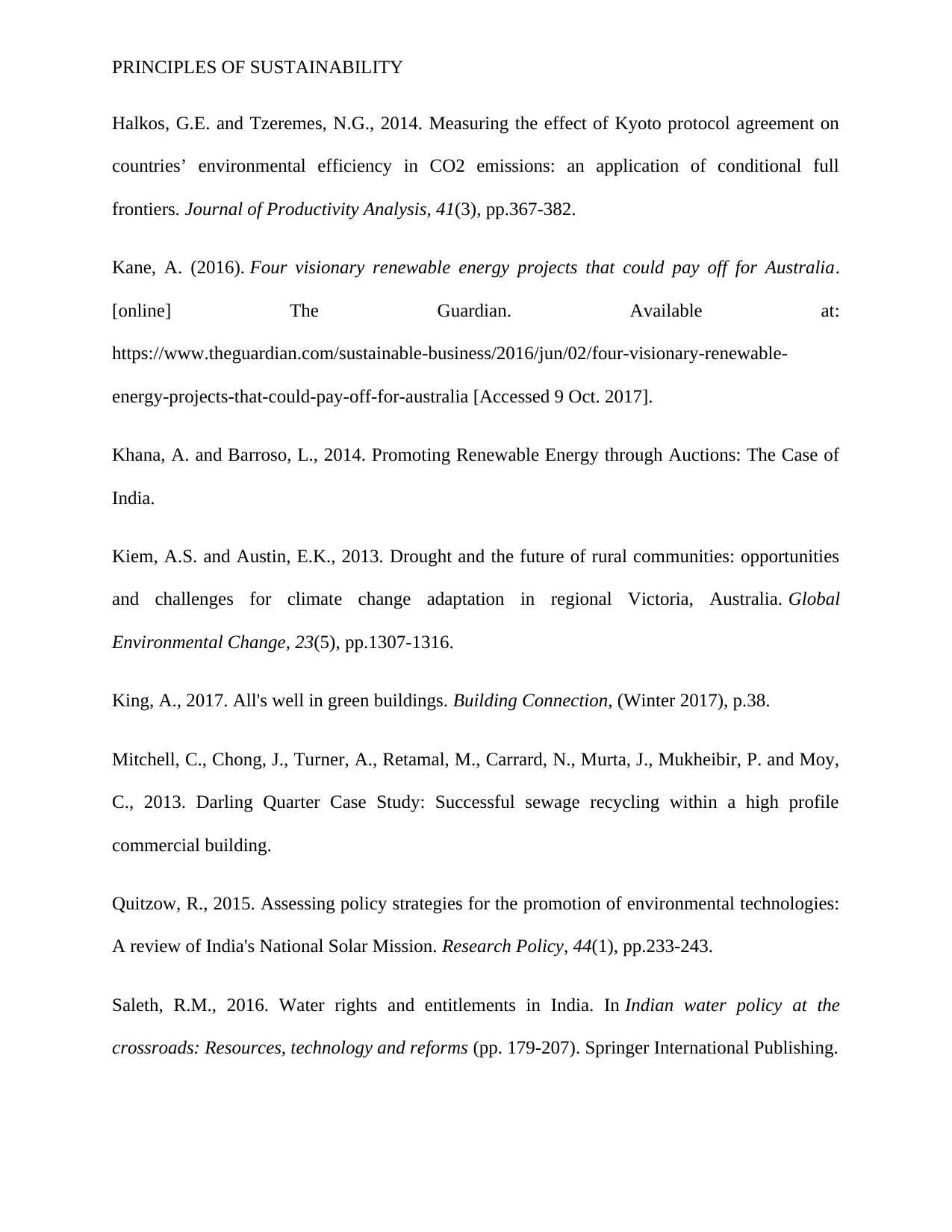
PRINCIPLES OF SUSTAINABILITY
Halkos, G.E. and Tzeremes, N.G., 2014. Measuring the effect of Kyoto protocol agreement on
countries’ environmental efficiency in CO2 emissions: an application of conditional full
frontiers. Journal of Productivity Analysis, 41(3), pp.367-382.
Kane, A. (2016). Four visionary renewable energy projects that could pay off for Australia.
[online] The Guardian. Available at:
https://www.theguardian.com/sustainable-business/2016/jun/02/four-visionary-renewable-
energy-projects-that-could-pay-off-for-australia [Accessed 9 Oct. 2017].
Khana, A. and Barroso, L., 2014. Promoting Renewable Energy through Auctions: The Case of
India.
Kiem, A.S. and Austin, E.K., 2013. Drought and the future of rural communities: opportunities
and challenges for climate change adaptation in regional Victoria, Australia. Global
Environmental Change, 23(5), pp.1307-1316.
King, A., 2017. All's well in green buildings. Building Connection, (Winter 2017), p.38.
Mitchell, C., Chong, J., Turner, A., Retamal, M., Carrard, N., Murta, J., Mukheibir, P. and Moy,
C., 2013. Darling Quarter Case Study: Successful sewage recycling within a high profile
commercial building.
Quitzow, R., 2015. Assessing policy strategies for the promotion of environmental technologies:
A review of India's National Solar Mission. Research Policy, 44(1), pp.233-243.
Saleth, R.M., 2016. Water rights and entitlements in India. In Indian water policy at the
crossroads: Resources, technology and reforms (pp. 179-207). Springer International Publishing.
Halkos, G.E. and Tzeremes, N.G., 2014. Measuring the effect of Kyoto protocol agreement on
countries’ environmental efficiency in CO2 emissions: an application of conditional full
frontiers. Journal of Productivity Analysis, 41(3), pp.367-382.
Kane, A. (2016). Four visionary renewable energy projects that could pay off for Australia.
[online] The Guardian. Available at:
https://www.theguardian.com/sustainable-business/2016/jun/02/four-visionary-renewable-
energy-projects-that-could-pay-off-for-australia [Accessed 9 Oct. 2017].
Khana, A. and Barroso, L., 2014. Promoting Renewable Energy through Auctions: The Case of
India.
Kiem, A.S. and Austin, E.K., 2013. Drought and the future of rural communities: opportunities
and challenges for climate change adaptation in regional Victoria, Australia. Global
Environmental Change, 23(5), pp.1307-1316.
King, A., 2017. All's well in green buildings. Building Connection, (Winter 2017), p.38.
Mitchell, C., Chong, J., Turner, A., Retamal, M., Carrard, N., Murta, J., Mukheibir, P. and Moy,
C., 2013. Darling Quarter Case Study: Successful sewage recycling within a high profile
commercial building.
Quitzow, R., 2015. Assessing policy strategies for the promotion of environmental technologies:
A review of India's National Solar Mission. Research Policy, 44(1), pp.233-243.
Saleth, R.M., 2016. Water rights and entitlements in India. In Indian water policy at the
crossroads: Resources, technology and reforms (pp. 179-207). Springer International Publishing.
⊘ This is a preview!⊘
Do you want full access?
Subscribe today to unlock all pages.

Trusted by 1+ million students worldwide

PRINCIPLES OF SUSTAINABILITY
Teske, S., Dominish, E., Ison, N. and Maras, K., 2016. Renewable Energy for Australia–
Decarbonising Australia’s Energy Sector within one Generation.
Teske, S., Dominish, E., Ison, N. and Maras, K., 2016. Renewable Energy for Australia–
Decarbonising Australia’s Energy Sector within one Generation.
1 out of 10
Related Documents
Your All-in-One AI-Powered Toolkit for Academic Success.
+13062052269
info@desklib.com
Available 24*7 on WhatsApp / Email
![[object Object]](/_next/static/media/star-bottom.7253800d.svg)
Unlock your academic potential
Copyright © 2020–2025 A2Z Services. All Rights Reserved. Developed and managed by ZUCOL.





